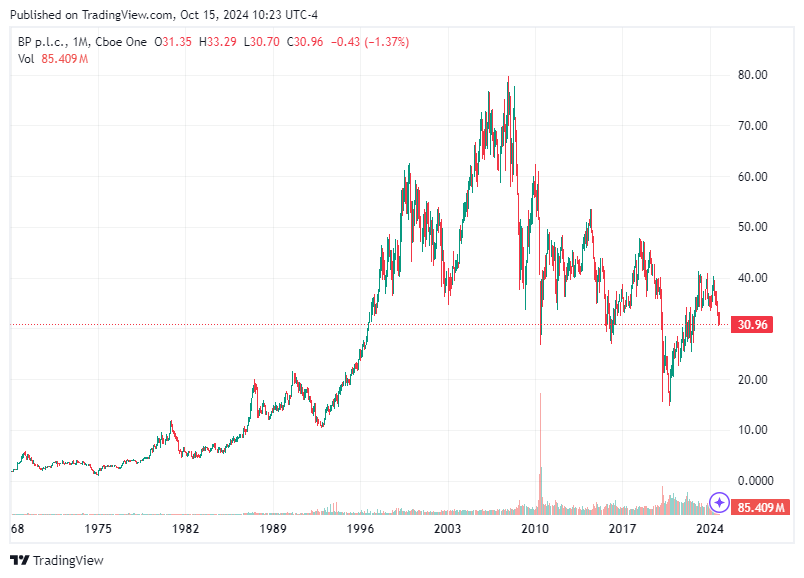Oil Giant Warns of Earnings Decline
BP Warns of Earnings Decline Amid Weak Refining Margins.

Disclaimer: The following article is intended for informational purposes only and should not be construed as financial or investment advice. The content reflects general market trends and insights related to BP and the broader oil industry as of the latest available data. Readers should conduct their own research or consult with a financial advisor for advice tailored to their individual circumstances.
BP, one of the world's largest oil companies, recently issued a cautionary statement indicating that its third-quarter earnings are expected to suffer notably due to weakened refining margins. This anticipated decline, ranging from $400 million to $600 million, highlights the challenges facing BP and the broader oil industry amidst fluctuating market conditions. The situation is compounded by diminished sales of oil products and increased write-offs in exploration efforts, creating a multifaceted impact on BP’s financial health.
Refining margins are a critical measure of profitability for oil companies like BP, reflecting the difference between the cost of raw crude and the selling price of refined products. In recent months, BP has experienced a notable drop in these margins, with averages falling from $20.6 per barrel in previous quarters to $16.5 per barrel in the third quarter. This decline is expected to result in a substantial financial hit, estimated at $400 million to $600 million.
This decrease in margins can be attributed to key factors, including lower global oil demand and economic slowdowns in key markets such as China. As the largest importer of crude oil, China's economic policies and growth rates play a pivotal role in shaping global oil demand. Recent slowdowns have led to reduced consumption, thereby impacting refining margins. Since taking over as BP's CEO in January, Murray Auchincloss has faced numerous challenges in steering the company through turbulent times. One of his primary tasks has been to regain investor confidence, which has been shaken by declining earnings and a lagging share price—down more than 12% over the year.
Auchincloss has tactically refocused BP towards its core oil and gas operations, a move exemplified by the sanctioning of the Kaskida field development in the Gulf of Mexico. This initiative highlights BP's commitment to bolstering its traditional energy portfolio amidst a shifting global landscape. In contrast, Auchincloss has also signaled a retreat from certain renewable ventures, such as the sale of BP's US onshore wind farms. This indicates a pivot towards prioritizing profitability and core competencies within the oil and gas sectors, even as the company maintains a broader commitment to sustainable energy solutions.
Market Context and Geopolitical Influences
The challenges BP faces are reflective of broader market dynamics within the oil industry. Global oil demand has been tempered by several macroeconomic factors, including the aforementioned slowdown in China and geopolitical tensions in the Middle East. The latter has periodically driven up oil prices due to fears of supply disruptions, particularly amid escalating hostilities involving Israel and Iran.
Oil prices, particularly those of Brent crude, have seen fluctuating trends as a result of these tensions. In the third quarter, Brent crude averaged around $80.34 per barrel, a decrease from previous highs but punctuated by occasional spikes due to geopolitical anxieties. The oil market is experiencing a delicate balance between supply and demand. Analysts predict that if oil production ramps up in 2025, it could further depress prices, challenging the profitability of oil majors like BP and complicating their ability to maintain shareholder returns.
BP's current financial challenges and decisions are part of a broader narrative within the energy sector, where companies must navigate a complex interplay of market forces, environmental considerations, and technological advancements. The transition towards sustainable energy, while still a goal for BP, must be balanced against immediate financial realities.
For BP, the path forward involves addressing immediate financial pressures while positioning itself for long-term sustainability. This includes managing its debt levels effectively, particularly as net debt is projected to rise due to deferred proceeds from divestments. Additionally, maintaining capital discipline and optimizing its asset portfolio will be crucial in navigating the uncertain landscape. The oil industry's future will likely be shaped by the ongoing evolution of global energy policies, technological innovations, and consumer preferences. For companies like BP, adapting to these changes while ensuring financial resilience will be key to sustaining their market position and driving future growth.
BP's recent warning of a decline in earnings due to weak refining margins highlights the intricate challenges facing the oil industry today. With economic slowdowns, geopolitical tensions, and shifting energy paradigms, the sector is undergoing substantial transformation. BP's responses, under the leadership of Murray Auchincloss, demonstrate a commitment to navigating these challenges and positioning the company for future success. As the global energy landscape continues to evolve, BP's journey will be one to watch closely, offering insights into the broader dynamics at play within the oil market.
Disclaimer: This article is provided for informational purposes only. The views expressed herein are those of the author and do not necessarily reflect the views or opinions of BP or any of its affiliates. The information contained in this article should not be relied upon for investment decisions. Always consult a qualified financial advisor before making investment choices.
We are working endlessly to provide free insights on the stock market every day, and greatly appreciate those who are paid members supporting the development of the Stock Region mobile application. Stock Region offers daily stock and option signals, watchlists, earnings reports, technical and fundamental analysis reports, virtual meetings, learning opportunities, analyst upgrades and downgrades, catalyst reports, in-person events, and access to our private network of investors for paid members as an addition to being an early investor in Stock Region. We recommend all readers to urgently activate their membership before reaching full member capacity (500) to be eligible for the upcoming revenue distribution program. Memberships now available at https://stockregion.net


